Photography courtesy of Lowell Washburn, all rights reserved.
If I had to pick one month of the year as my favorite, October would certainly rank high on the list. October is the Gateway to Fall — the final transition between summer and autumn. While oak forests remain green; sumac, cottonwood, and maples are on fire. For the most part, October skies are the bluest blue. By contrast, puffy clouds are the whitest of the year. October is cool in the shade, but warm in the sun. All in all, October weather is as good as it gets.
Although there are a million things to do at this time of the year, I always devote the first week of October to a single activity — which is the hunting of Canada geese. Whether the location is cow pasture, cut corn, or recently harvested bean field — the sight of incoming, locked on Canada geese never fails to thrill me to my very core. I normally hunt over a big spread and, during late season when the snow flies, like to pool my decoys with other like minded Canada goose addicts. But this week, my tactics have been outside the norm. I’ve been hunting in the marsh over water and my spread has consisted of a mere ten decoys. September was unseasonably warm and windy, and the marsh is drying up. One of the places the geese have been frequenting lies in the middle of the section. Getting there involves a fair hike through prairie grasses and a bit of slogging through the boot sucking mud that lines the margin of a growing mud flat. Ten decoys — 7 floaters and 3 full bodied standers — [plus gun, snacks, coffee, and camera] is all I can manage to carry.
It would be easier to kill geese in nearby pasture lands or silage fields. But I come here instead simply because there is so much more to see in the marsh. This morning was a good example. As soon as daybreak began to color the eastern skies, the wetland began to stir. Mallards and wood ducks buzzed my makeshift willow blind. I could hear geese farther down the line, and pretty soon the first flocks of Canadas were on the wing. A flock of five gave me a look but, at the last minute, said “No thanks” and continued on. Just coming off water themselves, it came as no surprise when the early birds ignored my decoys and flew in a direct line toward a picked cornfield where I had permission to hunt. But with shallow water and plenty of black oozy mud for loafing, I hoped my pond would appear more attractive once the honkers had eaten their fill of waste grain and headed back to water.

My dreams of returning geese were suddenly interrupted by the loud bugling of incoming swans. A couple of minutes later the flock appeared over the willows and, within seconds, I had nine trumpeter swans swimming beyond the decoys. The flock consisted of an adult pair with five young, and another pair of adults with no young. Whether in the air or on the water, the massive size of our largest waterfowl never fails to impress.
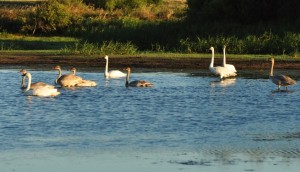
Flocks of shorebirds began to arrive and I soon had killdeer, yellowlegs, sandpipers, and snipe feeding nearby. Killdeer were the most numerous, and certainly the most vocal, of the little waders. Before long, some of the killdeer began to engage in a tactic I call “tremor feeding”. Moving through knee deep water, the birds would stop every step or two and violently quiver one of their legs. What is actually happening is that the bird is using its toes to thoroughly stir and probe the muddy marsh bottom for invertebrates. Whenever a morsel is discovered, the toes kick the item to the surface where the killdeer promptly gobbles it up. Amazingly, most people have never observed this common killdeer behavior. The show continued as new flocks of yellowlegs continued to arrive. Eventually the birds were feeding on all sides of the open water. Before long, both greater and lesser yellowlegs were literally walking through and around my goose decoys.

I was suddenly jarred to my senses by the sound of approaching geese. I could tell by the excited vocalizations that it was a pair of Canadas, and their agitated and aggressive tones left no question that the geese were already committed to making the pond their own. Without turning my head, I scrunched lower in the blind and slowly traded camera for shotgun. By the time the exchange was complete, the clamoring geese had closed to within 20 yards. I had the pair dead to rights and it was as ‘Good as Done’ when I stood to fire. I stoned the first bird with the first barrel, and then lifted my head off the stock and missed the second honker clean. Not the first time that’s happened, and likely not the last. The goose I killed was a heavy bird. When I picked him tonight, he was reasonably fat and pleasingly free of pin feathers. From gullet to gizzard, the plump Canada was absolutely loaded with corn. I love it when a plan comes together.
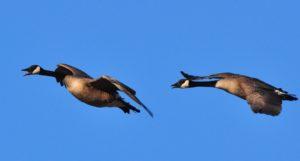
October passes all too quickly, and I plan on being back in the blind well before daybreak tomorrow. If any geese come to the decoys, I’ll be sure to keep my head on the stock.

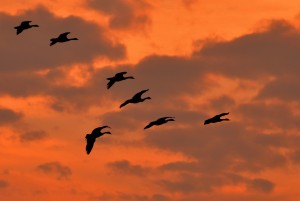
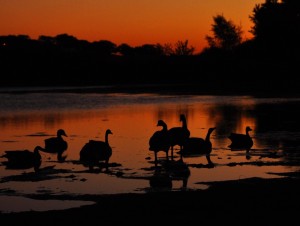
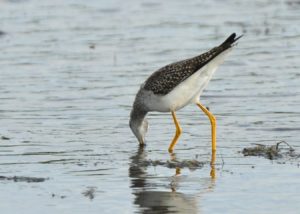
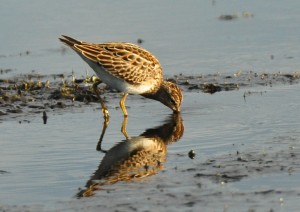
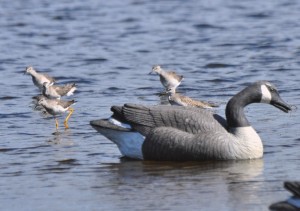
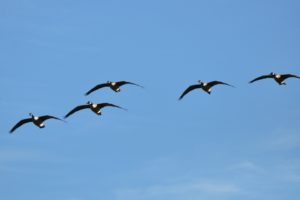
 Tom Cope
Tom Cope Sue Wilkinson
Sue Wilkinson Susan Judkins Josten
Susan Judkins Josten Rudi Roeslein
Rudi Roeslein Elyssa McFarland
Elyssa McFarland Mark Langgin
Mark Langgin Adam Janke
Adam Janke Joe Henry
Joe Henry Kristin Ashenbrenner
Kristin Ashenbrenner Joe Wilkinson
Joe Wilkinson Dr. Tammy Mildenstein
Dr. Tammy Mildenstein Sean McMahon
Sean McMahon